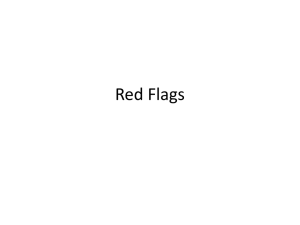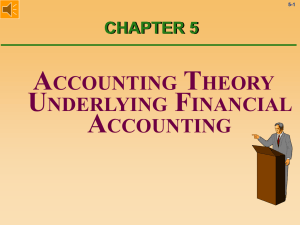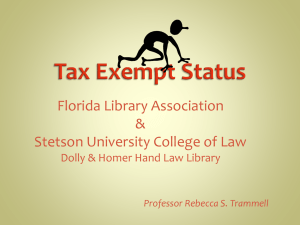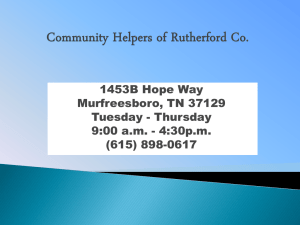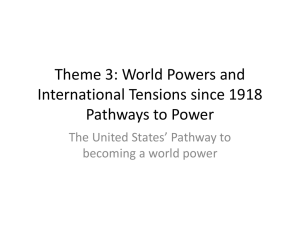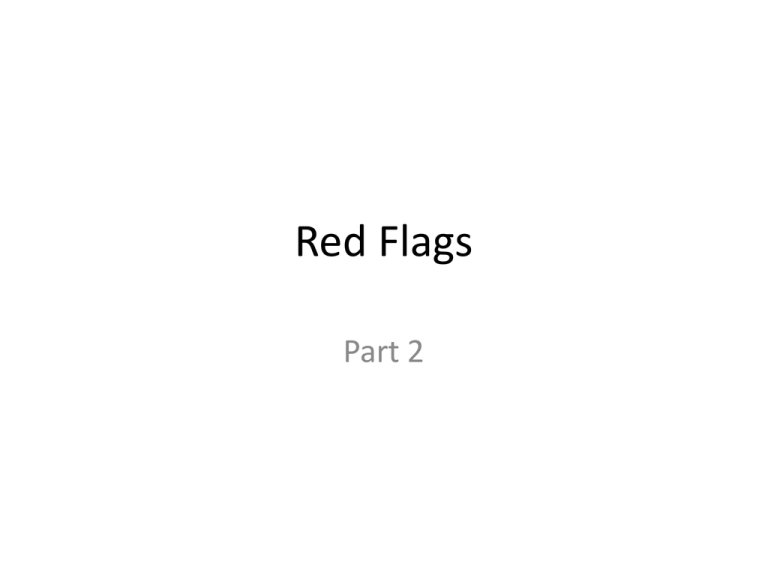
Red Flags
Part 2
Introduction
• Purpose:
– To show visually what bankers may see in
transactional activity that may uncover certain
financial crimes.
• The red flags are reviewed from the FFIEC BSA
/ AML Manual as well as FATF reports on
criminal activity
Introduction
Red Flags
• Red Flag Examples Part 2 Money Laundering
• The following examples are meant for bankers to visually
note transactional activity they may notice in review of
their everyday reports. These are only of few examples of
many and will hopefully help to develop a reporting
structure to make a more efficient and well documented
AML Program. These examples are simple and brief, good
launderers may have very complex and intricate laundering
schemes
• It’s important for bankers to stay up to date on all current
information provided by law enforcement, FinCEN and your
regulator.
Other Financial Crimes
Terrorist Financing
Terrorist Financing:
• Terrorists generally finance their activities
through both unlawful and legitimate sources.
Unlawful activities, such as extortion, kidnapping,
and narcotics trafficking, have been found to be a
major source of funding. Other observed
activities include smuggling, fraud, theft, robbery,
identity theft, use of conflict diamonds and
improper use of charitable or relief funds. In the
last case, donors may have no knowledge that
their donations have been diverted to support
terrorist causes.
Terrorist Financing
• Other legitimate sources have also been found
to provide terrorist organizations with
funding; these legitimate funding sources are
a key difference between terrorist financiers
and traditional criminal organizations. In
addition to charitable donations, legitimate
sources include foreign government sponsors,
business ownership, and personal
employment.
What to look for Red Flags
• Exact dollar amounts for all types of transactions
• International transactions to “High Risk” locations
• Look at source and destination of funds does the
“flow” of the money make sense
• Review beneficial ownership of the accounts
• Business front (Non-profit or cash intensive
business)
• Cash ins in some cases are performed on the
same business day, however, different branches
are used.
What to look for
Backroom Reports Review
• Exact amount in the Wire, ACH, Cash and check reports
• Transactions with exact dollar amounts (not all the time)
• Look destination of funds where and who the funds go to
and how they got there.
– Are the funds going to places associated with your customer
• Online payment transactions that have little information
provided and are unusual for the type of business and / or
account holder
• Any linkage between customers that may be noted in CIP /
CDD information (i.e. occupation type of business,
expected activity etc)
• Funds Transferred to high risk locations (i.e. off shore tax
haven accounts)
Front Line staff: Key Points
• Transactions with exact dollar amounts
• Any comments the customer makes concerning
the transactions or their business
• Any mention of the reporting thresholds when
deposits made.
• The Bank is unable to obtain sufficient
information or information is unavailable to
positively identify originators or beneficiaries of
accounts or other banking activity (using Internet,
commercial database searches, or direct inquiries
to a respondent bank).
Documentation needed
• Notes from the front line on comments the
customer may have made
• Source and destination of funds
• All web searches for information on the customer
and customer’s business
• If non-profit look for benefactors and type of
non-profit
• Obtain and document beneficial ownership of
any business the customer may open or be
associated with
Terrorist Financing
• Customer owns non-profit and receives online
donations from pay-pal as well as deposits
funds from donations
• From the donations customer then transfers
funds to individuals that have no known
association with the non-profit
Notice the exact amounts in and out
Terrorist Financing
1)
2)
From review of backroom reports
look for large exact dollar
deposits, withdraws and / or
transfers in and out
From CIP and CDD Reviews,
review and document the type of
non-profit and who are the
benefactors from the funds
Notice the wires out to high
risk domestic locations
Summary
Terrorist Financing Possible Hawala
• Customer owns cash intensive business and
makes routine cash deposits into its business
account.
• The customer then shows wires out and
international ACH transactions out to high risk
areas to unknown beneficiaries
Notice the business type,
would it normally perform
foreign wires
Terrorist Financing
Possible Hawala
Customer owns Sub Shop receives
cash in that it deposits into its business
account. The customer then shows
wires out and Pay-Me ACH out to high
risk areas and unknown beneficiaries
Notice transfers may not
be only wires some online
payment systems allow
transfers
Notice exact amounts in and
out
Summary
Terrorist Financing
• Customer receives large and frequent deposits
from online payments systems yet has no
apparent online or auction business.
Suspicious Non-Cash
Deposits / Terrorist
Financing
Customer receives large and frequent
deposits from online payments
systems yet has no apparent online or
auction business.
Summary
Human Trafficking
Human Trafficking
• Trafficking in Persons as the recruitment,
transportation, transfer, harbouring or receipt of
persons, by means of the threat or use of force or
other forms of coercion, of abduction, of fraud, of
deception, of the abuse of power or of a position of
vulnerability or of the giving or receiving of payments
or benefits to achieve the consent of a person having
control over another person, for the purpose of
exploitation. Exploitation shall include, at a minimum,
the exploitation of the prostitution of others or other
forms of sexual exploitation, forced labour or services,
slavery or practices similar to slavery, servitude or the
removal of organs
What to look for Red Flags
• Exact dollar amounts for all types of transactions
• International transactions to “High Risk” locations
• Look at source and destination of funds does the
“flow” of the money make sense
• Review beneficial ownership of the accounts
• Business front (Non-profit or cash intensive business)
• Cash ins in some cases are performed on the same
business day, however, different branches are used.
• Internet purchases, Point of sale, ATM and / or credit
card transactions in high risk locations or on adult /
unknown web sites
What to look for
Backroom Reports Review
• Exact amount in the Wire, ACH, Cash and check reports
• Transactions with exact dollar amounts (not all the time)
• Look destination of funds where and who the funds go to and how
they got there.
– Are the funds going to places associated with your customer
• Online payment transactions that have little information provided
and are unusual for the type of business and / or account holder
• Any linkage between customers that may be noted in CIP / CDD
information (i.e. occupation type of business, expected activity etc)
• Funds Transferred to high risk locations (i.e. off shore tax haven
accounts)
• Internet purchases, Point of sale, ATM and / or credit card
transactions in high risk locations or on adult / unknown web sites
Front Line staff: Key Points
• Transactions with exact dollar amounts
• Any comments the customer makes concerning
the transactions or their business (i.e. reporting
thresholds on any type of transactions)
• The Bank is unable to obtain sufficient
information or information is unavailable to
positively identify originators or beneficiaries of
accounts or other banking activity (using Internet,
commercial database searches, or direct inquiries
to a respondent bank).
Documentation Recommended
• Notes from the front line on comments the
customer may have made
• Source and destination of funds
• All web searches for information on the
customer and customer’s business
• If non-profit look for benefactors and type of
non-profit
• Obtain and document beneficial ownership of
any business the customer may open or be
associated with
Organized Crime and Drug
Trafficking
Organized Crime and Drug Trafficking
• Organized Crime A widespread group of
professional criminals who rely on illegal
activities as a way of life and whose activities
are coordinated and controlled through some
form of centralized syndicate.
• Drug trafficking is a global illicit trade involving
the cultivation, manufacture, distribution and
sale of substances which are subject to drug
prohibition laws.
What to look for Red Flags
• Exact dollar amounts for all types of transactions
• International transactions to “High Risk” locations
• Look at source and destination of funds does the
“flow” of the money make sense
• Review beneficial ownership of the accounts
• Business front (Non-profit or cash intensive business)
• Cash ins in some cases are performed on the same
business day, however, different branches are used.
• Internet purchases, Point of sale, ATM and / or credit
card transactions in high risk locations or on adult /
unknown web sites
What to look for
Backroom Reports Review
• Exact amount in the Wire, ACH, Cash and check reports
• Transactions with exact dollar amounts (not all the time)
• Look destination of funds where and who the funds go to and how
they got there.
– Are the funds going to places associated with your customer
• Online payment transactions that have little information provided
and are unusual for the type of business and / or account holder
• Any linkage between customers that may be noted in CIP / CDD
information (i.e. occupation type of business, expected activity etc)
• Funds Transferred to high risk locations (i.e. off shore tax haven
accounts)
• Internet purchases, Point of sale, ATM and / or credit card
transactions in high risk locations or on adult / unknown web sites
Front Line staff: Key Points
• Transactions with exact dollar amounts
• Any comments the customer makes concerning
the transactions or their business (i.e. reporting
thresholds on any type of transactions)
• The Bank is unable to obtain sufficient
information or information is unavailable to
positively identify originators or beneficiaries of
accounts or other banking activity (using Internet,
commercial database searches, or direct inquiries
to a respondent bank).
Corruption / PEP
Politically exposed person
• The term "politically exposed person"
generally includes a current or former senior
foreign political figure, their immediate family,
and their close associates. Interagency
guidance issued in January 2001 offers banks
resources that can help them to determine
whether an individual is a PEP
• Identify the accountholder and beneficial owner, including
the nominal and beneficial owners of companies, trusts,
partnerships, private investment companies, or other legal
entities that are accountholders.
• Seek information directly from the account holder and
beneficial owner regarding possible PEP status.
• Identify the accountholder’s and beneficial owner’s country
of residence and the level of risk for corruption and money
laundering associated with these jurisdictions.
• Obtain information regarding employment, including
industry and sector and the level of risk for corruption
associated with the industries and sectors.
• Check references, as appropriate, to determine whether the account
holder and beneficial owner is or has been a PEP.
• Identify the account holder’s and beneficial owner’s source of wealth and
funds.
• Obtain information on immediate family members or close associates
either having transaction authority over the account or benefiting from
transactions conducted through the account.
• Determine the purpose of the account and the expected volume and
nature of account activity.
• Make reasonable efforts to review public sources of information. These
sources will vary depending upon each situation; however, banks should
check the accountholder and any beneficial owners of legal entities
against reasonably accessible public sources of information (e.g.,
government databases, major news publications, commercial databases
and other databases available on the Internet, as appropriate).
What to look for Red Flags
• Exact dollar amounts for all types of transactions
• International transactions to “High Risk” locations
• Look at source and destination of funds does the
“flow” of the money make sense
• Review beneficial ownership of the accounts
• Business front (Non-profit or cash intensive business)
• Cash ins in some cases are performed on the same
business day, however, different branches are used.
• Internet purchases, Point of sale, ATM and / or credit
card transactions in high risk locations or on adult /
unknown web sites
What to look for
Backroom Reports Review
• Exact amount in the Wire, ACH, Cash and check reports
• Transactions with exact dollar amounts (not all the time)
• Look destination of funds where and who the funds go to and how
they got there.
– Are the funds going to places associated with your customer
• Online payment transactions that have little information provided
and are unusual for the type of business and / or account holder
• Any linkage between customers that may be noted in CIP / CDD
information (i.e. occupation type of business, expected activity etc)
• Funds Transferred to high risk locations (i.e. off shore tax haven
accounts)
• Internet purchases, Point of sale, ATM and / or credit card
transactions in high risk locations or on adult / unknown web sites
Front Line staff: Key Points
• Transactions with exact dollar amounts
• Any comments the customer makes concerning
the transactions or their business (i.e. reporting
thresholds on any type of transactions)
• The Bank is unable to obtain sufficient
information or information is unavailable to
positively identify originators or beneficiaries of
accounts or other banking activity (using Internet,
commercial database searches, or direct inquiries
to a respondent bank).
Ponzi Schemes
• A Ponzi scheme is an investment fraud that
involves the payment of purported returns to
existing investors from funds contributed by new
investors. Ponzi scheme organizers often solicit
new investors by promising to invest funds in
opportunities claimed to generate high returns
with little or no risk. In many Ponzi schemes, the
fraudsters focus on attracting new money to
make promised payments to earlier-stage
investors and to use for personal expenses,
instead of engaging in any legitimate investment
activity
What to look for Red Flags
• Exact dollar amounts for all types of transactions
• International transactions to “High Risk” locations
• Look at source and destination of funds does the
“flow” of the money make sense
• Review beneficial ownership of the accounts
• Business front (Non-profit or cash intensive business)
• Cash ins in some cases are performed on the same
business day, however, different branches are used.
• Internet purchases, Point of sale, ATM and / or credit
card transactions in high risk locations or on adult /
unknown web sites
What to look for
Backroom Reports Review
• Exact amount in the Wire, ACH, Cash and check reports
• Transactions with exact dollar amounts (not all the time)
• Look destination of funds where and who the funds go to and how
they got there.
– Are the funds going to places associated with your customer
• Online payment transactions that have little information provided
and are unusual for the type of business and / or account holder
• Any linkage between customers that may be noted in CIP / CDD
information (i.e. occupation type of business, expected activity etc)
• Funds Transferred to high risk locations (i.e. off shore tax haven
accounts)
• Internet purchases, Point of sale, ATM and / or credit card
transactions in high risk locations or on adult / unknown web sites
Front Line staff: Key Points
• Transactions with exact dollar amounts
• Any comments the customer makes concerning
the transactions or their business (i.e. reporting
thresholds on any type of transactions)
• The Bank is unable to obtain sufficient
information or information is unavailable to
positively identify originators or beneficiaries of
accounts or other banking activity (using Internet,
commercial database searches, or direct inquiries
to a respondent bank).

